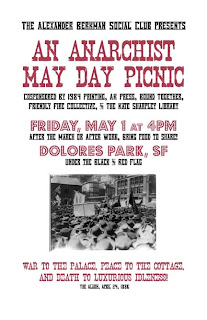 EDWARD CARPENTER: A LIFE OF LIBERTY AND LOVE
EDWARD CARPENTER: A LIFE OF LIBERTY AND LOVEBy Sheila Rowbotham
Noted socialist feminist historian Shelia Rowbotham will be giving a series of lectures on her recent book on Edward Carpenter throughout January around the Bay Area. Check them out!
Thursday, January 8, 2009, 6-7:30 pm
San Francisco Main Library,100 Larkin Street in the Latino/Hispanic Room.
The event is co-sponsored by the SF Public Library Hormel Center, the Edward Carpenter Forum and the SF GLBT Historical Society.
In conjunction with Rowbotham's appearance, the Library will mount the exhibit, My Days and Dreams: The Worlds of Edward Carpenter, Early Gay Freedom Pioneer, during the month of January on the 3rd floor of the Main Library.
Sunday, January 11, 2009, 2-4 pm
Bound Together Bookstore 1369 Haight Street
San Francisco, CA 94117
415.431-8355
Wednesday, January 14, 2009, 7:30 PM
Moe’s Books 2476 Telegraph Avenue
Berkeley CA 94704
Thursday, January 22, 2009 , 7:00 PM
Alexander Berkman Social Club
552 Valencia Street
San Francisco, CA 94110
The first major biography of late Victorian sexual and political libertarian, Edward Carpenter, by renowned feminist historian, Sheila Rowbotham. A rare document of the alternative lifestyles and radicalism of Carpenter's times by a woman who was on the frontline of the left and feminist movements of the sixties.
Edward Carpenter, libertarian and campaigner for gay love, women's suffrage, nudism and recycling, was a central figure in the cultural and political landscape of late nineteenth and early twentieth centuries. Meticulously researched and beautifully written, this biography situates
Carpenter's life and thought in relation to the social, aesthetic and intellectual movements of his day, and explores his friendship with figures such as Walt Whitman, Robert Graves, Oscar Wilde, E.M. Forster, Isadora Duncan and Emma Goldman.
With a commitment to bringing out the range of interconnections evident in Carpenter's life, through his network, his mix of causes, his interests and his thinking, Rowbotham knits together a great alternative social history of Victorian England and presents a compelling portrait of a man described by his contemporaries as a "weather-vane" for his times.





 Of course food (popcorn!) & refreshments will be available. We hope that you can make it to this exciting event.
Of course food (popcorn!) & refreshments will be available. We hope that you can make it to this exciting event.









 On December 6, an Athens cop shot and killed a young unarmed anarchist, Alexis Grigoropoulos. In a matter of hours, Athens exploded in a mass uprising of anarchists, students, migrant workers, and the unemployed. For over two weeks, in their anger and frustration, they attacked not just the police themselves but the oppressive institutions cops are armed to defend: banks, government buildings, multi-national corporate interests. Not since 1968 had Europe seen such militant and targeted mass direct action, and actions around the world echoed the heroic actions of our comrades in Greece. Not far from where I am writing, in San Francisco, solidarity actions were held and moving speeches given decrying police violence and the state capitalist hierarchies such violence is inevitably in service of, and vowing to “bring the fight home.”
On December 6, an Athens cop shot and killed a young unarmed anarchist, Alexis Grigoropoulos. In a matter of hours, Athens exploded in a mass uprising of anarchists, students, migrant workers, and the unemployed. For over two weeks, in their anger and frustration, they attacked not just the police themselves but the oppressive institutions cops are armed to defend: banks, government buildings, multi-national corporate interests. Not since 1968 had Europe seen such militant and targeted mass direct action, and actions around the world echoed the heroic actions of our comrades in Greece. Not far from where I am writing, in San Francisco, solidarity actions were held and moving speeches given decrying police violence and the state capitalist hierarchies such violence is inevitably in service of, and vowing to “bring the fight home.” Sadly, the fight has, once again, come home. On New Years Day in Oakland, an unarmed butcher and father from Hayward, Oscar Grant, was shot in the back at point blank range by a transit cop after being pinned face-down on the ground. There can be absolutely no justification for this cold-blooded police murder. As was the case in the murder of Alexis, there are several witnesses who have come forward stating the officer was in no danger, some even with video recordings of the atrocity. Predictably, though, the cop who fired the shot, Johannes Mehserle, has not been arrested or even officially interrogated about the incident. This is no surprise; we know how the authorities will respond (or fail to), given their total disregard for the lives and humanity of working and poor people of color.
Sadly, the fight has, once again, come home. On New Years Day in Oakland, an unarmed butcher and father from Hayward, Oscar Grant, was shot in the back at point blank range by a transit cop after being pinned face-down on the ground. There can be absolutely no justification for this cold-blooded police murder. As was the case in the murder of Alexis, there are several witnesses who have come forward stating the officer was in no danger, some even with video recordings of the atrocity. Predictably, though, the cop who fired the shot, Johannes Mehserle, has not been arrested or even officially interrogated about the incident. This is no surprise; we know how the authorities will respond (or fail to), given their total disregard for the lives and humanity of working and poor people of color.
